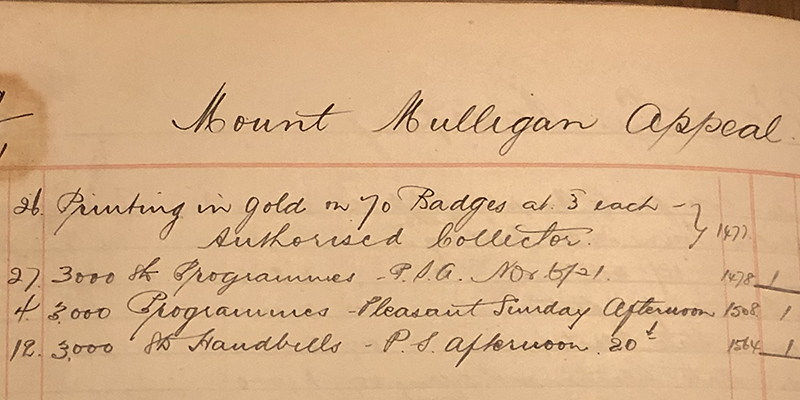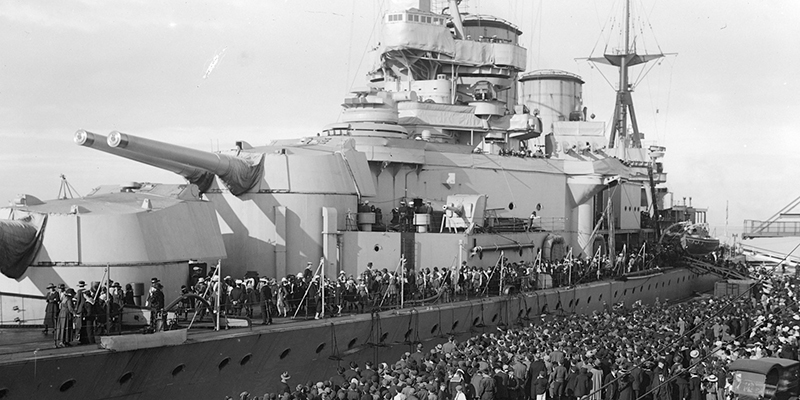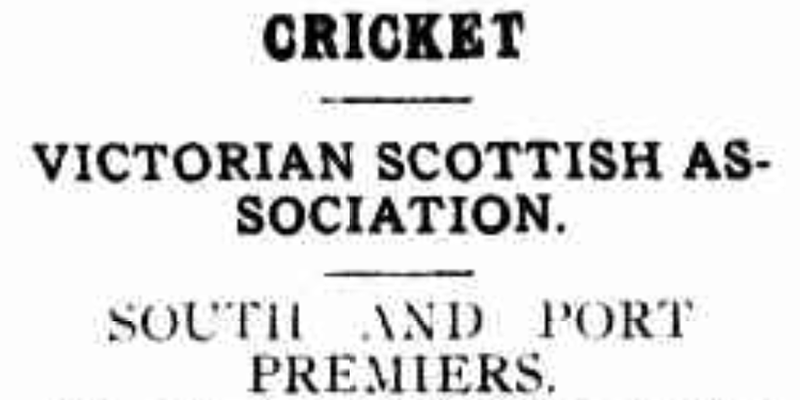Marshall & Co, Boot Manufacturers
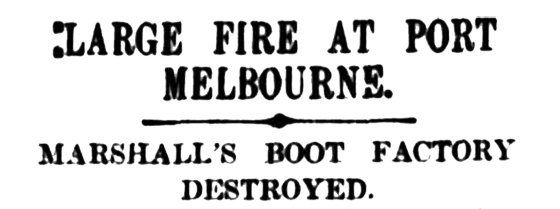
At about half past 6 o’clock yesterday evening a fire broke out in Marshall’s Boot Factory, in Nott Street, Port Melbourne, and in less than two hours, destroyed the whole of the building and a large quantity of stock, the whole valued about £10,000.
The Argus, 18 September 1901
Readers of The Argus on the morning of 18 September 1901 were greeted by the news that the very significant factory of Marshall & Co, Boot Manufacturers in Port Melbourne had been destroyed by fire on the previous evening.
The factory was a three-storey brick building facing onto Nott Street opposite the school and backing onto Lalor street. The ground floor was the riveting branch, the first floor was the finishing branch while the top floor housed over 100 machines for sewing uppers and a large number of iron pots in which wax was melted for waxing the hemp used in sewing. The third floor was also known as the clickers’ or girls finishing room. It is believed the fire started on that floor either in the oil room or near the wax thread machinery.
The Society was unaware of any photos of the building until the purchase a couple of months ago of this very faded view of the building c. 1900.
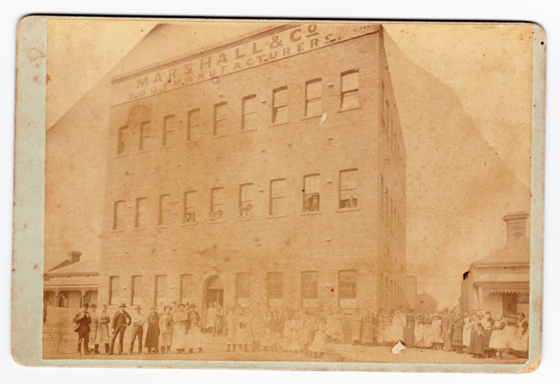
The photo helps place the factory as the laneway on the right still exists today running from Nott Street to Lalor Street.
Marshall & Co was formed by William Marshall who was retired at the time of the fire with his son Graham managing the warehouse in Melbourne and his other son Hector, manager of the destroyed Port Melbourne factory. The company also had retail premises in Bay Street as well as other suburbs in Melbourne and interstate.
The Port Melbourne factory was built in 1888 with the Standard newspaper reporting that
Mr Marshall, the well-known boot and shoe manufacturer, is building new and substantial brick premises in Nott Street opposite the State school. The building will extend to Lalor Street, and will prove a welcome addition to our native industries.
Standard, 14 April 1888
By the time the fire brigade arrived at the building and directed their hoses to the flames the water pressure was very low and had little effect on the well-established fire fuelled by the combustible material stored in the building and the oil saturated flooring on the top floor.
According to the Standard newspaper,
… an awfully grand spectacle was presented to the thousands of onlookers who had gathered from all parts not only of Port Melbourne, but also Melbourne and the other suburbs.
Standard, 21 September 1901
There was a lot of vacant ground about, and the crowd, which quickly gathered was able, without in any way interfering with the work of the firemen, to obtain an excellent view of what was for about an hour an awe-inspiring sight.
The Argus, 18 September 1901
While The Age that same morning provided a most poetic description of the fire.
At 7.45 the flames were at their grandest, the whole huge warehouse was a glowing cavern of fire, against which the puny streams of water seemed to sputter in vain. An enormous column of smoke, spangled with myriads of sparks and glowing with beautiful colours at the base, towered up hundreds of feet into the still and brilliant night, while the tall brick chimney shone blood red in the flames like a slender pyramid of fabulous stone. The roof fell in, in thunder and flame, and soon afterwards the whole of the upper story [sic] along the north side came crashing down amid gorgeous bursts of golden sparks. To add to the weird splendor [sic] of the scene the ghostly beam of a man of war’s search light swept round from the Bay, and mingled with the ruddier light from the conflagration.
The Age, 18 September 1901
[Note: The Age has referred to the side walls of the building as north and south whereas The Argus has used west and east. This story has adopted the orientation used in The Age although the truth lies somewhere in-between with Nott Street running in a north-easterly direction from the beach]
With the battle against the fire in the main building lost, the fire fighters turned their attention to the weatherboard cottages nearby. Unfortunately, a five-roomed double-fronted villa occupied by James Freely immediately adjoining the north side of the factory was wrecked by a falling wall. On the other side, the small weatherboard cottage occupied by Frank Lee was destroyed when the south wall of the factory collapsed. Both these houses are shown in the photo. The fire also damaged a house at the rear of the property, fronting Lalor Street, owned by Mr Marshall.
The occupants of the damaged houses, thankfully uninjured, were accommodated overnight at the State school through the efforts of Mr A Martin, the school caretaker.
Strong winds on the following Saturday morning caused the remaining factory walls to rock to an alarming extent. About 11.00 am a large portion of the north wall collapsed and completely demolished the wooden cottage on Lalor Street that had been slightly damaged during the fire then shortly afterwards the wall along Lalor Street came down.
Ten days after the fire, the Herald reported that,
… on seeing Messrs Marshall & Co at Port Melbourne, that they have already given definite instructions for the erection of another factory at Burnley, Palmer and Murphy streets, Richmond.
The Herald, 27 September 1901
The lost of the building in Port meant that some 300 people were now without work. The newspapers at the time expressed the hope that they would find work in the new premises in Richmond or elsewhere in the boot making trade.
The company were keen to reassure the public that they were still in business with the following advertisement appearing in The Standard on 21 December 1901.
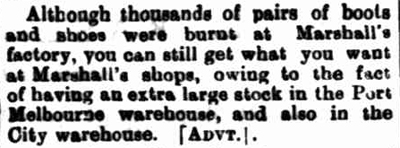
Today, nothing of the three-storey Marshall & Co building remains in Nott Street, however, keen-eyed pedestrians will note that four houses on the site of the former factory are set much further back from the footpath than the older houses in the street giving some clue to the scale of the building.
The Society is lucky to have volunteers of the calibre of John Kirby who has brought his expert photographic imaging skills to the restoration of the faded Marshall’s photo that appeared earlier in this story.
Note: Mr James Freely’s double-fronted villa adjacent to the factory (left) and Mr Frank Lee’s weatherboard cottage across the laneway (right).
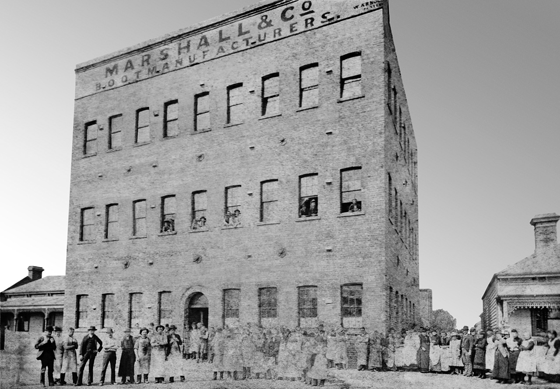
References
1888 ‘Items of News’, Standard (Port Melbourne, Vic. : 1884 – 1914), 14 April, p. 2. , viewed 17 Sep 2020, http://nla.gov.au/nla.news-article164934404
1894, ‘Advertising’, Standard (Port Melbourne, Vic. : 1884 – 1914), 16 June, p. 1. , viewed 17 Sep 2020, http://nla.gov.au/nla.news-page19820026
1901 ‘LARGE FIRE AT PORT MELBOURNE.’, The Argus (Melbourne, Vic. : 1848 – 1957), 18 September, p. 6. , viewed 17 Sep 2020, http://nla.gov.au/nla.news-article9608665
1901 ‘BIG FIRE AT PORT MELBOURNE.’, The Age (Melbourne, Vic. : 1854 – 1954), 18 September, p. 5. , viewed 17 Sep 2020, http://nla.gov.au/nla.news-article192212267
1901 ‘TWO COTTAGES SHATTERED.’, The Age (Melbourne, Vic. : 1854 – 1954), 18 September, p. 5. , viewed 17 Sep 2020, http://nla.gov.au/nla.news-article192212268
1901 ‘DESCRIPTION OF THE BUILDING AND CONTENTS.’, The Age (Melbourne, Vic. : 1854 – 1954), 18 September, p. 5. , viewed 17 Sep 2020, http://nla.gov.au/nla.news-article192212269
1901 ‘THE GREAT FIRE.’, Standard (Port Melbourne, Vic. : 1884 – 1914), 21 September, p. 2. , viewed 17 Sep 2020, http://nla.gov.au/nla.news-article164947704
1901 ‘MARSHALL’S BOOT FACTORY FIRE.’, The Argus (Melbourne, Vic. : 1848 – 1957), 23 September, p. 6. , viewed 17 Sep 2020, http://nla.gov.au/nla.news-article9609414
1901 ‘PORT MELBOURNE FIRE.’, The Herald (Melbourne, Vic. : 1861 – 1954), 27 September, p. 7. , viewed 17 Sep 2020, http://nla.gov.au/nla.news-article242999458
1901 ‘Items of News.’, Standard (Port Melbourne, Vic. : 1884 – 1914), 21 December, p. 2. , viewed 17 Sep 2020, http://nla.gov.au/nla.news-article164948461
Wikipedia contributors, “Boot and shoe clicker,” Wikipedia, The Free Encyclopedia, viewed 17 Sep 2020, https://en.wikipedia.org/w/index.php?title=Boot_and_shoe_clicker&oldid=969150848

